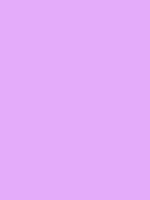#e4acfa Color Information
In a RGB color space, hex #e4acfa is composed of 89.4% red, 67.5% green and 98% blue. Whereas in a CMYK color space, it is composed of 8.8% cyan, 31.2% magenta, 0% yellow and 2% black. It has a hue angle of 283.1 degrees, a saturation of 88.6% and a lightness of 82.7%. #e4acfa color hex could be obtained by blending #ffffff with #c959f5. Closest websafe color is: #cc99ff.
-
- R 89
- G 67
- B 98
-
- C 9
- M 31
- Y 0
- K 2
● #e4acfa color description : Very soft violet.
#e4acfa Color Conversion
The hexadecimal color #e4acfa has RGB values of R:228, G:172, B:250 and CMYK values of C:0.09, M:0.31, Y:0, K:0.02. Its decimal value is 14986490.
| Hex triplet | e4acfa | #e4acfa |
|---|---|---|
| RGB Decimal | 228, 172, 250 | rgb(228,172,250) |
| RGB Percent | 89.4, 67.5, 98 | rgb(89.4%,67.5%,98%) |
| CMYK | 9, 31, 0, 2 | |
| HSL | 283.1°, 88.6, 82.7 | hsl(283.1,88.6%,82.7%) |
| HSV (or HSB) | 283.1°, 31.2, 98 | |
| Web Safe | cc99ff | #cc99ff |
| CIE-LAB | 77.817, 33.861, -30.871 |
|---|---|
| XYZ | 64, 52.902, 97.277 |
| xyY | 0.299, 0.247, 52.902 |
| CIE-LCH | 77.817, 45.821, 317.644 |
| CIE-LUV | 77.817, 25.182, -54.718 |
| Hunter-Lab | 72.734, 29.782, -28.383 |
| Binary | 11100100, 10101100, 11111010 |
Color Schemes with #e4acfa
Alternatives to #e4acfa
Below, you can see some colors close to #e4acfa. Having a set of related colors can be useful if you need an inspirational alternative to your original color choice.
#e4acfa Preview
This text has a font color of #e4acfa.
<span style="color:#e4acfa;">Text here</span>This paragraph has a background color of #e4acfa.
<p style="background-color:#e4acfa;">Content here</p>This element has a border color of #e4acfa.
<div style="border:1px solid #e4acfa;">Content here</div>.text {color:#e4acfa;}.background {background-color:#e4acfa;}.border {border:1px solid #e4acfa;}Shades and Tints of #e4acfa
A shade is achieved by adding black to any pure hue, while a tint is created by mixing white to any pure color. In this example, #07010a is the darkest color, while #fcf6fe is the lightest one.
-
#07010a
#07010argb(7,1,10) -
#15021c
#15021crgb(21,2,28) -
#22032f
#22032frgb(34,3,47) -
#300441
#300441rgb(48,4,65) -
#3d0554
#3d0554rgb(61,5,84) -
#4b0666
#4b0666rgb(75,6,102) -
#590779
#590779rgb(89,7,121) -
#66088b
#66088brgb(102,8,139) -
#74099e
#74099ergb(116,9,158) -
#810bb0
#810bb0rgb(129,11,176) -
#8f0cc3
#8f0cc3rgb(143,12,195) -
#9d0dd5
#9d0dd5rgb(157,13,213) -
#aa0ee8
#aa0ee8rgb(170,14,232)
-
#b418f1
#b418f1rgb(180,24,241) -
#ba2af2
#ba2af2rgb(186,42,242) -
#c03df3
#c03df3rgb(192,61,243) -
#c64ff4
#c64ff4rgb(198,79,244) -
#cc62f6
#cc62f6rgb(204,98,246) -
#d274f7
#d274f7rgb(210,116,247) -
#d887f8
#d887f8rgb(216,135,248) -
#de99f9
#de99f9rgb(222,153,249) -
#e4acfa
#e4acfargb(228,172,250) -
#eabffb
#eabffbrgb(234,191,251) -
#f0d1fc
#f0d1fcrgb(240,209,252) -
#f6e4fd
#f6e4fdrgb(246,228,253) -
#fcf6fe
#fcf6fergb(252,246,254)
Tones of #e4acfa
A tone is produced by adding gray to any pure hue. In this case, #d4d1d5 is the less saturated color, while #e5a9fd is the most saturated one.
-
#d4d1d5
#d4d1d5rgb(212,209,213) -
#d5ced8
#d5ced8rgb(213,206,216) -
#d7cadc
#d7cadcrgb(215,202,220) -
#d8c7df
#d8c7dfrgb(216,199,223) -
#dac4e2
#dac4e2rgb(218,196,226) -
#dbc0e6
#dbc0e6rgb(219,192,230) -
#ddbde9
#ddbde9rgb(221,189,233) -
#debaec
#debaecrgb(222,186,236) -
#e0b6f0
#e0b6f0rgb(224,182,240) -
#e1b3f3
#e1b3f3rgb(225,179,243) -
#e3aff7
#e3aff7rgb(227,175,247) -
#e4acfa
#e4acfargb(228,172,250) -
#e5a9fd
#e5a9fdrgb(229,169,253)
Color Blindness Simulator
Below, you can see how #e4acfa is perceived by people affected by a color vision deficiency. This can be useful if you need to ensure your color combinations are accessible to color-blind users.
